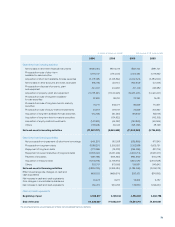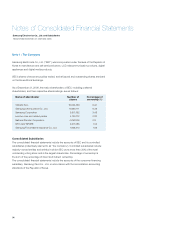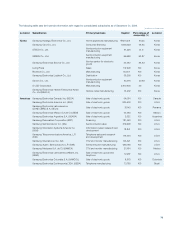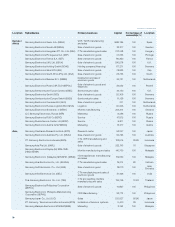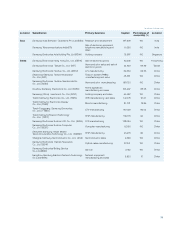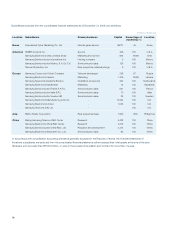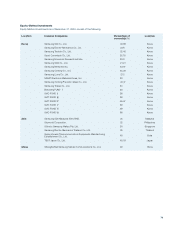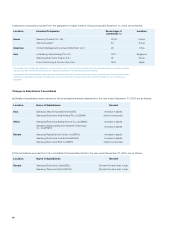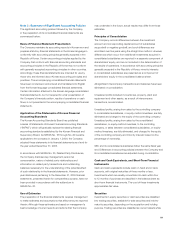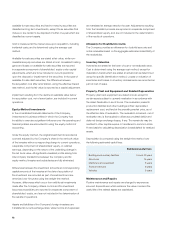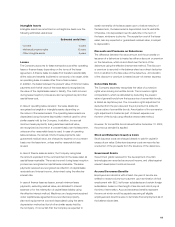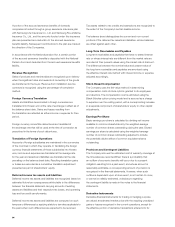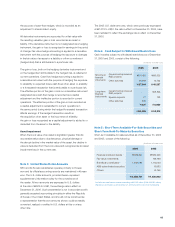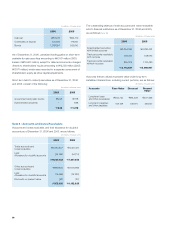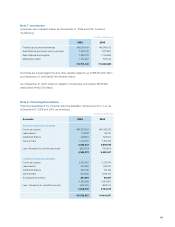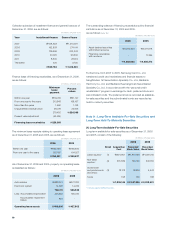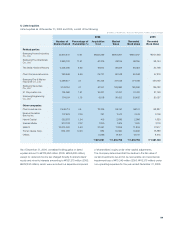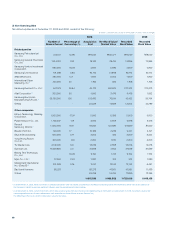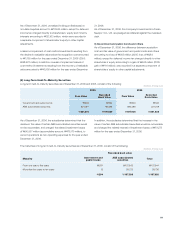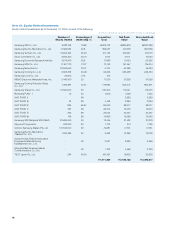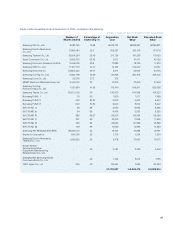Samsung 2006 Annual Report Download - page 93
Download and view the complete annual report
Please find page 93 of the 2006 Samsung annual report below. You can navigate through the pages in the report by either clicking on the pages listed below, or by using the keyword search tool below to find specific information within the annual report.
83
Intangible Assets
Intangible assets are amortized on a straight-line basis over the
following estimated useful lives:
Leases
The Company accounts for lease transactions as either operating
lease or finance lease, depending on the terms of the lease
agreement. A finance lease is a lease that transfers substantially
all the risks and rewards incidental to ownership of an asset, while
an operating lease is a lease other than a finance lease.
In addition, the lesser between the present value of minimum lease
payments and the fair value of the lease asset is recognized as
the value of the capital lease asset or liability. The costs incurred
during lease inception process are also recognized as part other
capital lease cost.
In case of operating lease as lessor, the lease assets are
recognized as tangible or intangible assets depending on
the nature of the leased assets. The operating lease assets are
depreciated using the same depreciation method used for other
similar assets held by the Company. In addition, the annual
minimum lease payments, less guaranteed residual value,
are recognized as income on a constant basis over the lease term,
unless another reasonable basis is used. In case of operating
lease as lessee, the annual minimum lease payments, less
guaranteed residual value, are charged to expense on a constant
basis over the lease term, unless another reasonable basis
is used.
In case of finance lease as lessor, the Company recognizes
the amount equivalent to the net investment in the lease asset as
capital lease receivable. The costs incurred during lease inception
process are recognized as capital lease receivable. The lease
payments received are recognized as collection of capital lease
receivable and interest income, determined using the effective
interest rate.
In case of finance lease as lessee, annual minimum lease
payments, excluding residual value, are allocated to interest
expense or for the redemption of capital lease liability using
the effective interest method. Machinery and equipment acquired
under capital lease agreements are recorded as property,
plant and equipment at cost and depreciated using the same
depreciation method as that of other similar assets held by
the Company. If it is certain that the Company is expected to
Estimated useful lives
Goodwill 5 years
Intellectual property rights 10 years
Other intangible assets 5 years
obtain ownership of the lease asset upon or before maturity of
the lease term, the lease asset is depreciated over its useful life.
Otherwise, it is depreciated over its useful life or the term of
the lease, whichever is shorter. The acquisition cost of the lease
asset, less any expected or guaranteed residual value, is subject
to deprecation.
Discounts and Premiums on Debentures
The difference between the value amount and the proceeds on
issuance of a debenture is treated as either a discount or premium
on the debenture, which is amortized over the term of the
debenture using the effective interest rate method. The discount
or premium is reported in the balance sheet as a direct deduction
from or addition to the face value of the debenture. Amortization
of the discount or premium is treated as part of interest expense.
Convertible Bonds
The Company separately recognizes the value of conversion
rights when issuing convertible bonds. The conversion rights
compensation, which is calculated by deducting the present
value of general bonds from the issue price of convertible bonds,
is stated as capital surplus. The conversion rights adjustment is
deducted from the par value and the put premium is added to
the par value of convertible bonds. Amortization of the conversion
right adjustment is treated as part of interest expense over
the term of the bonds using effective interest rate method.
However, for convertible bonds issued before December 31, 2002,
the previous standard is applied.
Stock and Debenture Issuance Costs
Stock issuance costs are charged directly to paid-in capital in
excess of par value. Debenture issuance costs are recorded as
a reduction of the proceeds from the issuance of the debenture.
Government Grants
Government grants received for the development of certain
technologies are recorded as accrued income, and offset against
relevant development costs as incurred.
Accrued Severance Benefits
Employees and directors with at least one year of service are
entitled to receive a lump-sum payment upon termination of their
employment with SEC, its Korean subsidiaries and certain foreign
subsidiaries, based on their length of service and rate of pay at
the time of termination. Accrued severance benefits represent
the amount which would be payable assuming all eligible
employees and directors were to terminate their employment as of
the balance sheet date.


